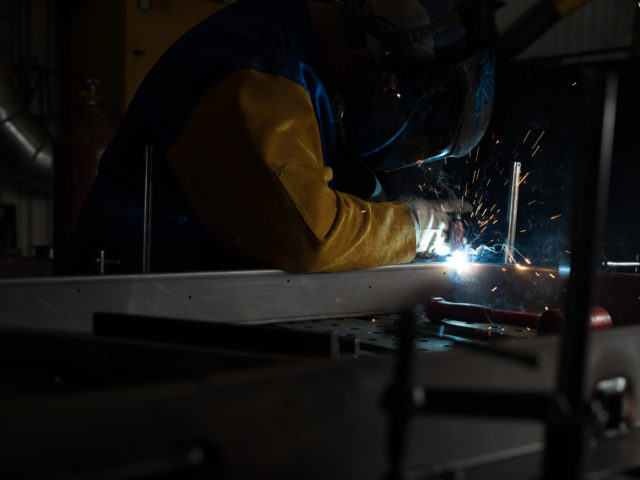Stainless steel metal fabrication is suitable for a wide range of industrial fabrication projects, especially where products will be subjected to wet, damp, humid, or corrosive conditions. As a material, its ability to fight rust is its prime selling point and a logical choice for products exposed to corrosive environments. But there is more to stainless steel than its corrosion-resistant properties. The environmentally friendly material is also known for its durability and low maintenance, high tensile strength, ease of formability, and temperature resistance. It is aesthetically appealing and has hygienic applications, too.
Nonetheless, selecting the right material for a fabrication project is important. There are plenty of options available. Custom fabricated products can be made from a range of metals and their alloys. Carbon steel, aluminum, copper, brass, as well as stainless steel, are common materials used in fabrication. Which metal to use will in large part be determined by its material properties in relation to its intended application.
Types of Metal Fabrication Materials
Carbon Steels
Carbon steels, which vary in carbon content from low to high, are noted for their high strength, durability, extreme hardness, and resistance to wear. They are ideal for building structures such as office buildings and bridges, in manufacturing vehicles, and for making tools, blades, punches, dies, high-strength wire, and springs. In general, carbon steels are stronger than stainless steel but have low corrosion-resistant properties. When exposed to moisture they will corrode and rust quickly.
Aluminum
Aluminum is another versatile material. It too offers corrosion resistance; is soft, malleable, and lightweight but also strong and durable. Aluminum is used in a wide variety of products and components—in the manufacture of cans, foils, kitchen utensils, appliances, electronics, and auto and aerospace components. It has structural and architectural applications as well, such as external facades, cladding, roofing, rails, window framing, and doors. Aluminum, unfortunately, cannot take the same stress as steel. Its malleable properties also make it prone to being dented or scratched more easily than stainless steel.
Copper
Because of its excellent heat conductivity, copper can be found lining the bottoms of stainless steel cookware. It’s also well-known for its electrical conductivity, along with good corrosion resistance. Malleable, durable, and ductile, too, copper is handy for piping and tubing but is not much in the way of building material. For architects, it does hold an aesthetic appeal. Copper is used for cladding, ornamentation, and roofing of buildings and structures. It must be cleaned regularly, otherwise, copper will lose its luster, and develop the familiar green patina as it oxidizes. The material cost of copper is expensive and exceeds that of stainless steel, which limits its use to certain applications, primarily for builders.
Brass
Like stainless steel, brass is known for its corrosion-resistant and antimicrobial properties and is also visually appealing. It is a popular choice for fixtures and other decorative and architectural applications ranging from hinges, doorknobs, lamps, and lighting to musical instruments, electronic packaging, roofing, and facade cladding. Though widely used for plating, polishing, and finishing products, brass has one big disadvantage. Though it does not corrode easily, it does oxidize when exposed to air, which makes it prone to blackish tarnishing that requires a great deal of maintenance to inhibit and remove. Brasses are also susceptible to stress corrosion cracking in certain environmental conditions.
Benefits of Stainless Steel Metal Fabrication
What makes stainless steel worth considering for fabrication projects is the advantages the material holds far outweigh its disadvantages. Stainless steel is exceptionally versatile. Its name, in general, represents a line of corrosion-resistant steel alloys that are formed by adding a minimum of 10.5% chromium to iron in combination with a small percentage of carbon. Other alloying elements such as nickel, manganese, and molybdenum are often combined to enhance material properties for specific applications. Chromium is the key alloying element, however, as it creates a protective, passive layer that gives the metal its defining property by shielding the iron against corrosion.
Of the many varieties of stainless steel, there are principally four main types—austenitic, ferritic, martensitic, and duplex—that comprise approximately 150 grades, each with unique properties. When considering the best material for a fabrication project, with its many characteristics, stainless steel offers engineers and designers many options. Most notably, yes, it is made to resist and withstand exposure to high humidity, seawater, brine, sulfuric acids, and corrosive chemicals found in natural and industrial environments. But it is a 100% recyclable material, too, with a limited environmental footprint on manufacturing and the products produced. Another important characteristic is the material’s high-heat resistance ideal for high-temperature applications such as pressure valves or water heaters.
In terms of fabrication, with the right equipment and tools, fabricators easily form, mold, weld, cut or stamp to design specifications and geometries. Because stainless steel has a non-porous surface, it is ideal for applications where sanitary conditions are a must. Bacteria, viruses, germs, and even stains cannot penetrate the material. Treatment with any antibacterial cleaner will leave surfaces free of contaminants. The material is well-suited for use in food manufacturing machinery, equipment, cookware, and cutlery, but also for medical devices, equipment, and components. The impenetrability of stainless steel also gives it a visually aesthetic appearance. The material is easy to clean and keep clean, resisting stains and rust.
In looking to start a new metal fabrication project, using the right material for the project is key to its success. Stainless steel has many properties ideally suited for metal fabrication and is worth considering for any new custom fabrication project. To learn more about stainless steel metal fabrication, please contact our expert team at Quest-Tech today!



